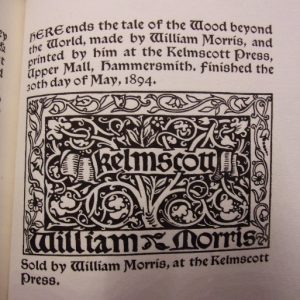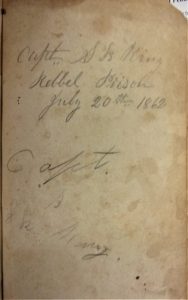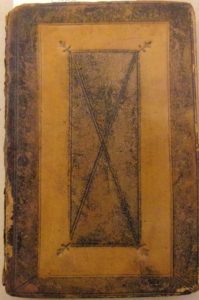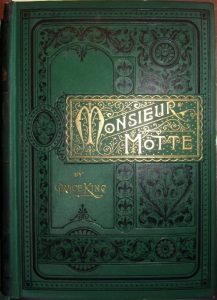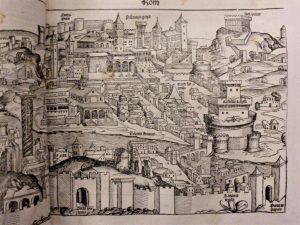What Makes a Book Rare?
By Michael Lear,
Rare Collections Librarian
State Library of Pennsylvania
Libraries with rare or special collections may be asked: what makes a book “rare” or valuable? Probably the most often thought of factor by is that a book is old. This is sometimes true but is certainly not a sole criterion. After all, age is relative and what is old to some may not be to others. Compared to the age of their civilizations, to Europeans something printed in the 1800s may not be considered that old, while to Americans it is, due to our shorter history. Certainly, incunabula (books printed before 1501 during the first decades of movable type printing) and earlier forms such as cuneiform, papyri, codices, and illuminated manuscripts are old and have a place as rare books in library special collections. However, in some cases, a newer book can be more valuable than an older one. An example of this may be an American “pioneer imprint” referring to an item printed in the first years of printing in a new territory or state. In this case, an item printed in Nevada in 1858 (the first known year of printing in the region) may be more scarce, valuable, and unique than many books printed earlier in Pennsylvania. Other factors, discussed later, have more of an impact on age alone.
Aside from being “old” another factor commonly forms the concept of a book being “rare” and valuable, the idea of scarcity based on there being few copies of a book available or in existence. While it is true that there may be few copies in existence, for dealers (and from the perspective of monetary value) the concept of scarce in the market relative to demand comes in to play as demand drives value. A scarce book is not valuable unless there is demand. One edition may be relatively scarce, but in context of accumulated editions and printings of the same title, the item is not in demand or valuable. An example of this may be bibles or classics of literature that were reprinted almost every year and in many locations. For librarians, the idea of monetary value is often of less importance than something being scarce or having other unique characteristics that can make something difficult or impossible to replace.
In addition to the more immediately identifiable characteristics of age, scarcity and value there are other unique or special properties that contribute to rarity, value, and desirability to collectors and libraries. These criteria, which can also be subjective and relative, are based on the antiquarian rare book trade and professional library practice. From a librarian’s perspective, these are codified through the very helpful ACRL Guidelines on the Selection and Transfer of Materials from General Collections to Special Collections (2016). The ACRL Guidelines include the previously mentioned factors of value, scarcity and age followed by additional criteria. These are the standards I use to determine if something should be transferred from our closed and open stacks to rare books. In addition, I use a point based- rubric in an attempt to quantify decision-making. The rubric allows balancing the various factors in the ACRL guidelines and customizes the weight (point value) of each criteria based on local interest, collection strengths, and collection focus. Decision making is a balance of a combination of factors, as any one factor may not justify inclusion in a rare books collection due to space issues, the impact of making marginal items non-circulating (thus making them less accessible to patrons), and diminishing the stand-out value of your rare books collection overall by including too many items in your collection.
Some libraries set a threshold for monetary value that may balance factors such as replacement cost, loss of an obvious asset, and where the threshold fits compared to the value of other items in the library’s collection. A lower threshold may work for a small collection, but may need to be higher if an unwieldy percentage of books would be added to a rare books collection based on that figure. Scarcity is a factor to consider based on a review of the holdings of other libraries and copies available for sale in the marketplace. Sometimes scarcity is built into a book by the publisher as a limited edition. This can be considered in decision-making but should be compared with library holdings and the antiquarian market as being a limited edition can, but does not automatically make an item valuable (especially if part of a larger run of a thousand or more copies). One caveat to using OCLC holdings as an indicator of rarity is that few copies held in libraries may be due to other factors such as deselection where an item that is too out of date (such as an early mass market textbook) or too general and lacking substantive information (such as picture book) may have been weeded or may not have been acquired. In many cases, items such as these are not scarce or valuable in the marketplace.
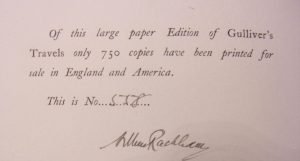
Limitation statement on a 1909 edition of Gulliver’s Travels. This special edition features illustrations by noted British illustrator Arthur Rackham and has added value by being hand-numbered and signed.
Condition and completeness are major factors affecting value. Are all volumes of a set present? Are all pages, illustrations, and maps present and intact? Does the book have its original binding, or has it been rebound? If the item is a mid to late-20th century novel, is the dust jacket present? A copy with library markings, rebound in a library binding, or in poor condition will as a rule have less value than a clean copy. However, if otherwise of extremely high value an item in lesser condition may retain a relatively high value such as being worth (for example) $1,000 instead of $10,000.
The date and place of publication and publisher can determine if a book may be desirable. American and foreign imprints before 1800 are items to consider, along with whether a book is a pioneer imprint and if the item was produced by a notable press desired by collectors, such as Benjamin Franklin’s, Kelmscott or Roycroft Presses.
A notable association or provenance of a book can be an important factor. Are there autographs or inscriptions by a prominent author or a famous person giving the item as a gift? Are there autographs of owners or bookplates affixed to the book that prove past ownership? This factor can be objective or subjective, in that a book autographed by Mark Twain (either one he wrote and autographed, or one he owned) would be more universally appealing, while an autograph of a local prominent person may only be of importance to a region. Nevertheless, an item associated with a prominent local person, would be a legitimate factor to consider.
Other items of note may be unique annotations and marginalia that accompany ownership marks and demonstrate how someone used the book and what they thought of parts of it. In the case of a fine or artistic binding, the binder or designer may be of interest to collectors and there may be a binder’s stamp present that identifies the binder, or the binder designer’s initials may be present as part of the cover design.

Gold-stamped ownership mark of the Assembly of Pennsylvania. This stamp identifies the provenance of this item as being part of the early library of the Pennsylvania Assembly authorized in 1745 when Benjamin Franklin, Clerk of the Assembly, was instructed to purchase law books for legislative use.
Several physical and intrinsic characteristics contributing to the aesthetic value of the book may be present. Is the binding original, well executed, and indicative of its time period as either a custom work, or as issued by the publisher? Or, is the binding a fine binding, meaning a custom produced re-binding with high quality materials and workmanship exemplifying binding as a craft and art form? Is the book an artists’ or manuscript book, completely handmade and one of a kind? High quality, often limited edition, facsimiles of works that would not be possible to acquire otherwise but serve a cultural and teaching purpose may also be considered for rare book collections. If they are faithful reproductions on quality paper, bound like the originals, they can retain value as collectibles. One example may be the Gutenberg Bible in which there are few or no copies available for sale at any price since there are only 49 Gutenberg Bibles in existence and only 21 of those are complete. Extra-illustrated books with bound in, or tipped in, documents and illustrations are unique items appropriate for rare book collections. Large size, fragile, or unusual formats vulnerable to loss or damage may be considered for adding to a rare books collection where handling is supervised. Examples may include large folios, heavily illustrated works, miniature books, and portfolios with loose plates.
From an intellectual content perspective, is the item a primary source, or contains significant or unusual subject matter? Does the book have bibliographic and research value as a notable or seminal work in a field of knowledge? For example, British magazine Nature issues from 1953 featuring the first publication of the work of Watson and Crick on DNA can be valuable. First editions, first printings of an item, rather than a later printing or edition are usually more desirable, although in some cases later editions with significant additions, or by a fine press printer may be of value.
An item can also possess what is known as evidential value when it contains notable features exemplifying the historical development of the printing and publishing trade and technological evolution. Items containing publishers’ advertisements, subscribers’ lists, various illustration methods, errors, unique typefaces, and various types of paper can be of interest.
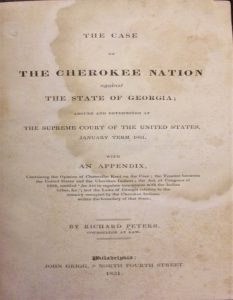
An example of an item valued as a primary source documenting the Cherokee Nation’s struggle to retain their land in the state of Georgia in the 1830s. It is also a Philadelphia imprint and is preserved in the State Library of Pennsylvania as part of the Pennsylvania imprint collection.
An example of a woodcut illustration of Rome from the Nuremberg Chronicle, 1493. Later types of illustrations using relief or intaglio methods introduced in subsequent centuries included, copper and steel plate engravings, etchings, wood engravings, stone lithography, photogravure, and offset lithography.
Finally, items can be desirable for a rare book collection due to factors such as fitting with a library’s subject focus, collecting interest, strengths, and local interest. For example, at the State Library of Pennsylvania, we have a large collection of Pennsylvania imprints to 1865, along with works related to Pennsylvania history, industries, and Harrisburg-related works that would not necessarily be of interest to a library outside the region. It is in this instance that we perhaps move into the realm of special collections as opposed to rare books. An example of a special collection may be genealogical and local history materials that serve a niche research purpose, even if not extremely unique or valuable.
Determining what is a rare book is a combination of objective and subjective criteria with perhaps no single factor more determinative than another. What is considered rare can exemplify more than one criteria and what’s unique and special to your library may not be for another, based on your collection and local interest.



